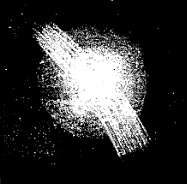Great Comet of 1823
 Coma and twin tails of the Great Comet of 1823. | |
| Discovery | |
|---|---|
| Discovered by | Nell de Bréauté |
| Discovery date | December 29, 1823 |
| Designations | |
| 1823; Great Comet of 1823, Comet De Bréauté-Pons | |
| Orbital characteristics | |
| Epoch | 1824 Feb 15.0(UT)[1] |
| Perihelion | 0.226742 AU |
| Eccentricity | 1.0 |
| Inclination | 103.8194 ° |
| Last perihelion | 1823 Dec 09.93400000 |
The Great Comet of 1823, also designated C/1823 Y1 or Comet De Bréauté-Pons, was a bright comet visible in the last month of 1823 and the first months of 1824.
It was independently discovered by Nell de Bréauté at Dieppe on December 29, by Jean-Louis Pons on the morning of December 30, and by Wilhelm von Biela at Prague on the same morning.[2] It was already visible to the naked eye when discovered: Pons initially thought he was seeing smoke from a chimney rising over a hill, but continued observing when he noticed it did not change appearance. He was later to note that the comet was, puzzlingly, more easily visible to the naked eye than through a telescope.[3]
The comet was particularly known at the time for exhibiting two tails, one pointing away from the Sun and the other (termed an "anomalous tail" by Harding and Olbers)[4] pointing towards it.
Pons was also the last astronomer to detect the comet, on April 1 1824.
References
- ^ Alan Chamberlin. "JPL Small-Body Database Browser". Ssd.jpl.nasa.gov. Retrieved 2016-01-20.
- ^ Kronk, G. Cometography: volume 2, CUP, 2003, pp.62-3. Some sources give December 24 as its discovery date, but this may be an error.
- ^ Kronk, p.64
- ^ Sekanina, Z., M. S. Hanner, E. K. Jessberger, and M. N. Fomenkova, Cometary Dust. In: Interplanetary Dust, E. Grun, B. A. S. Gustafson, S. F. Dermott, and H. Fechtig, Eds., Springer, Heidelberg, Germany, 2001, p.112


